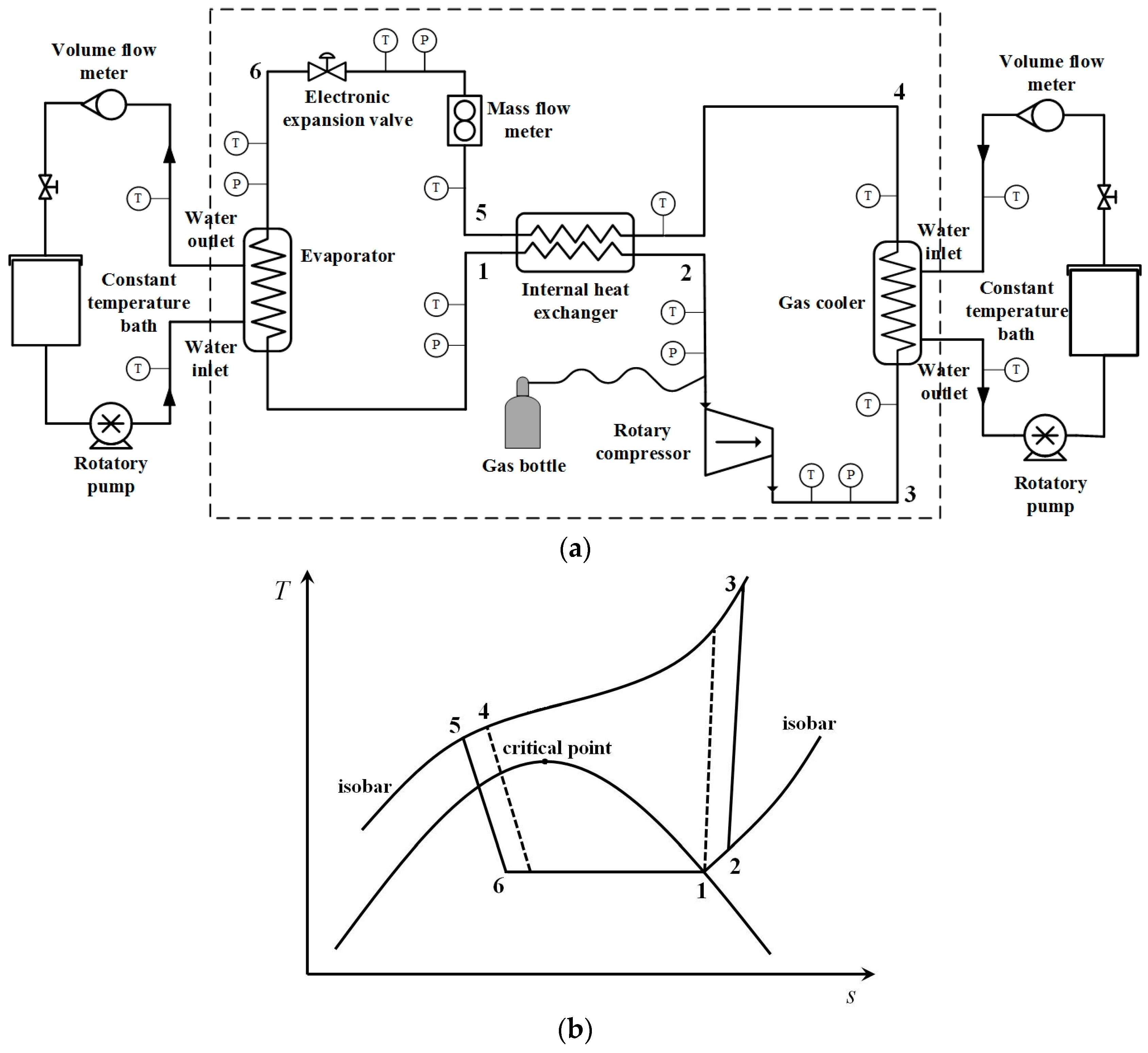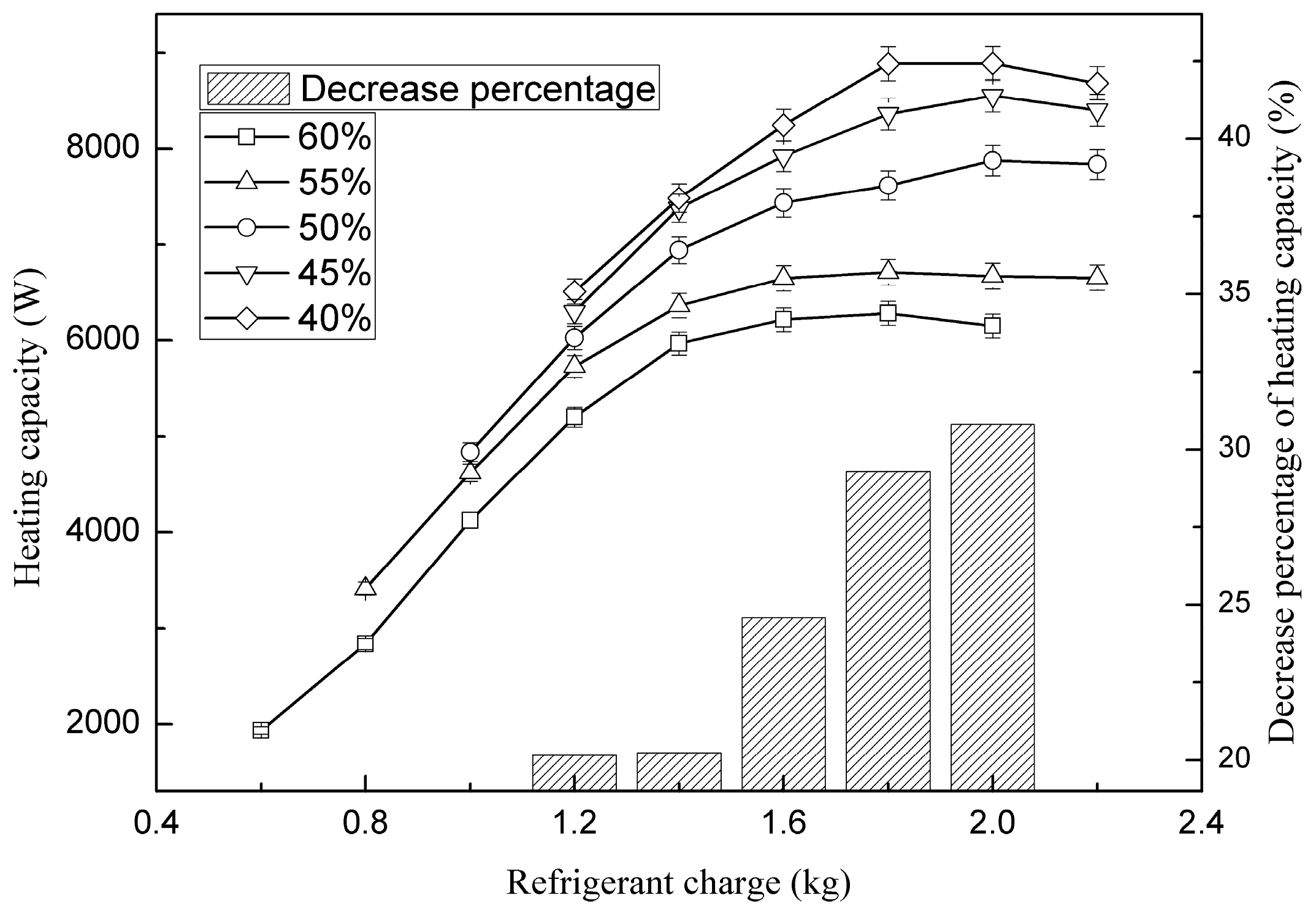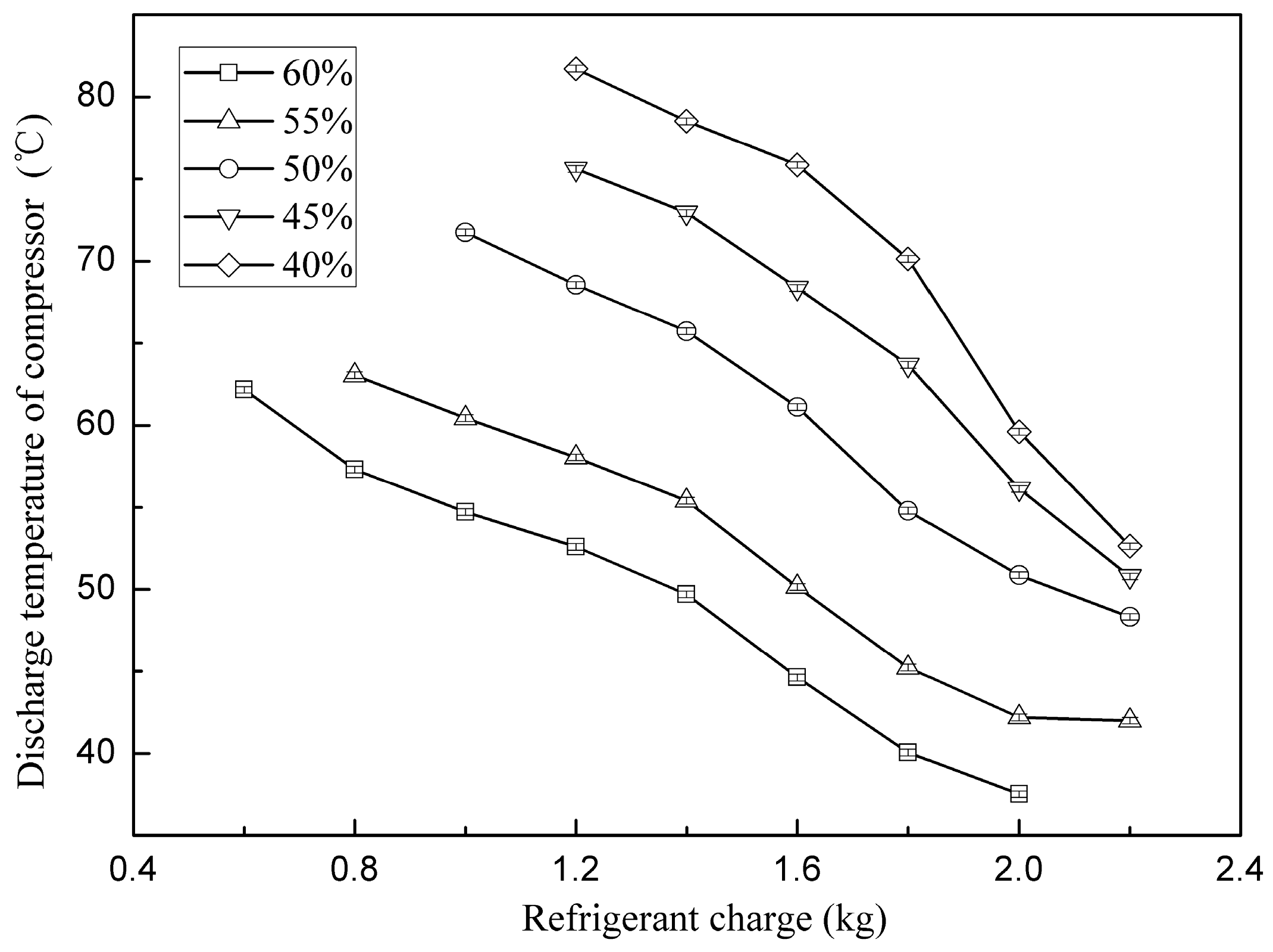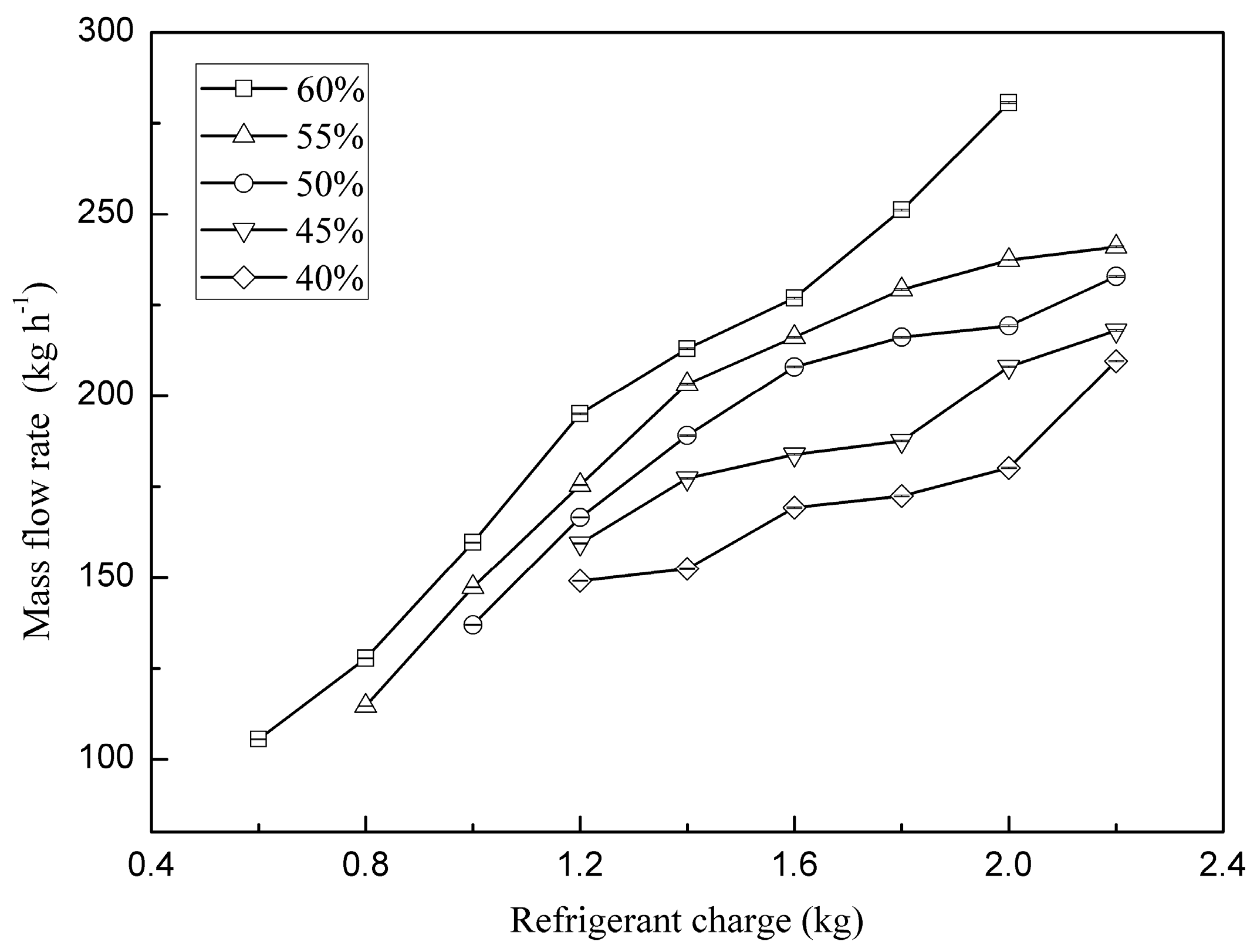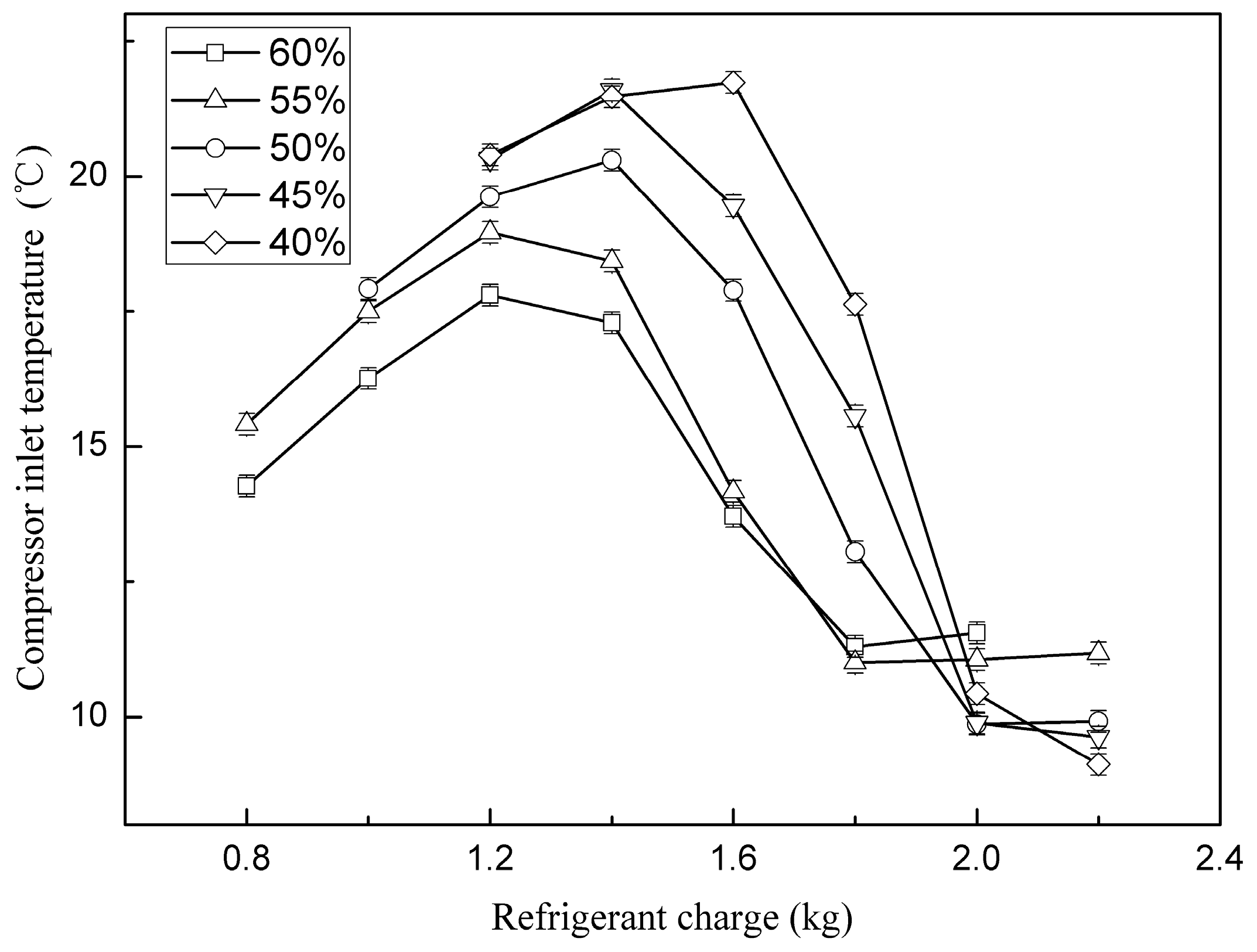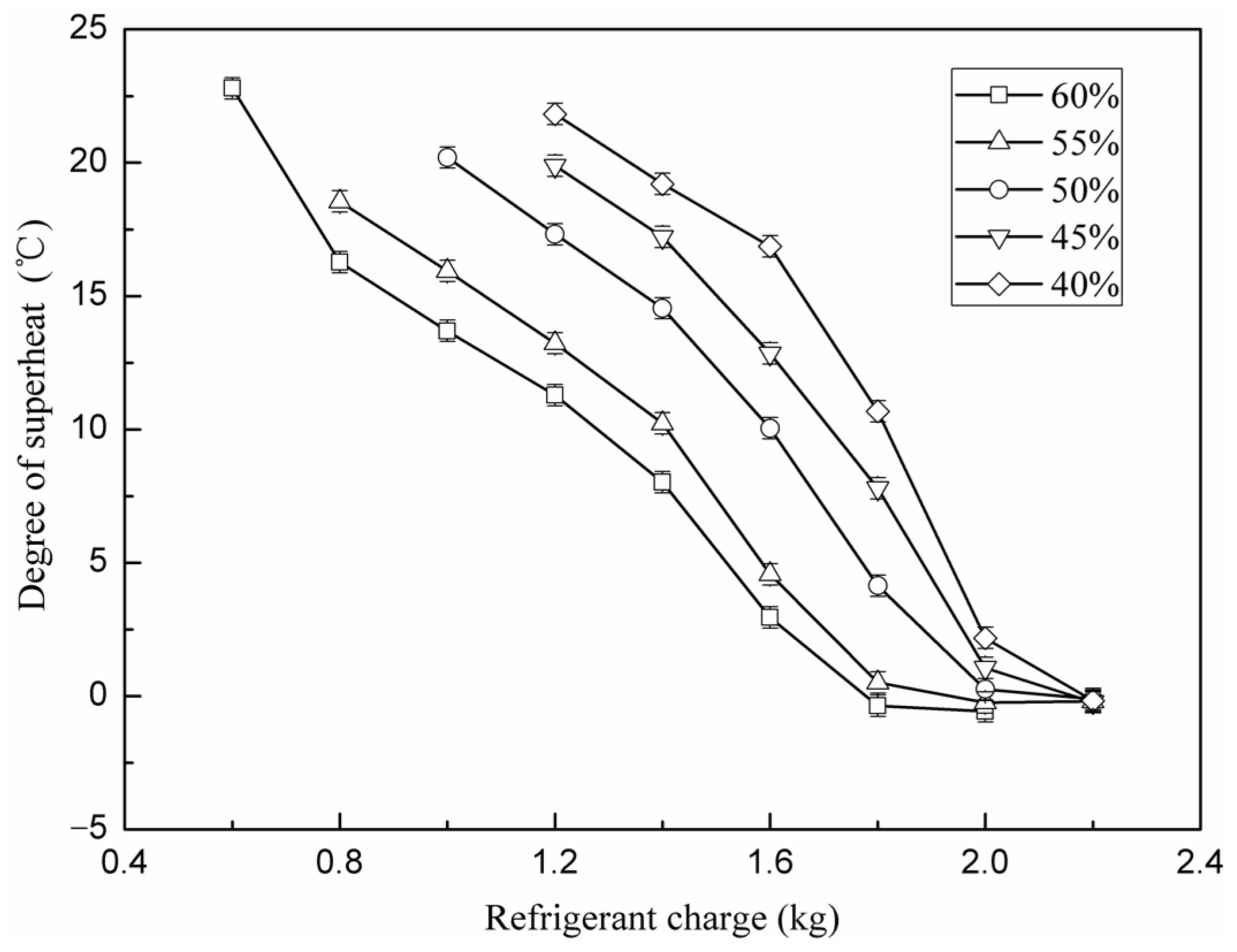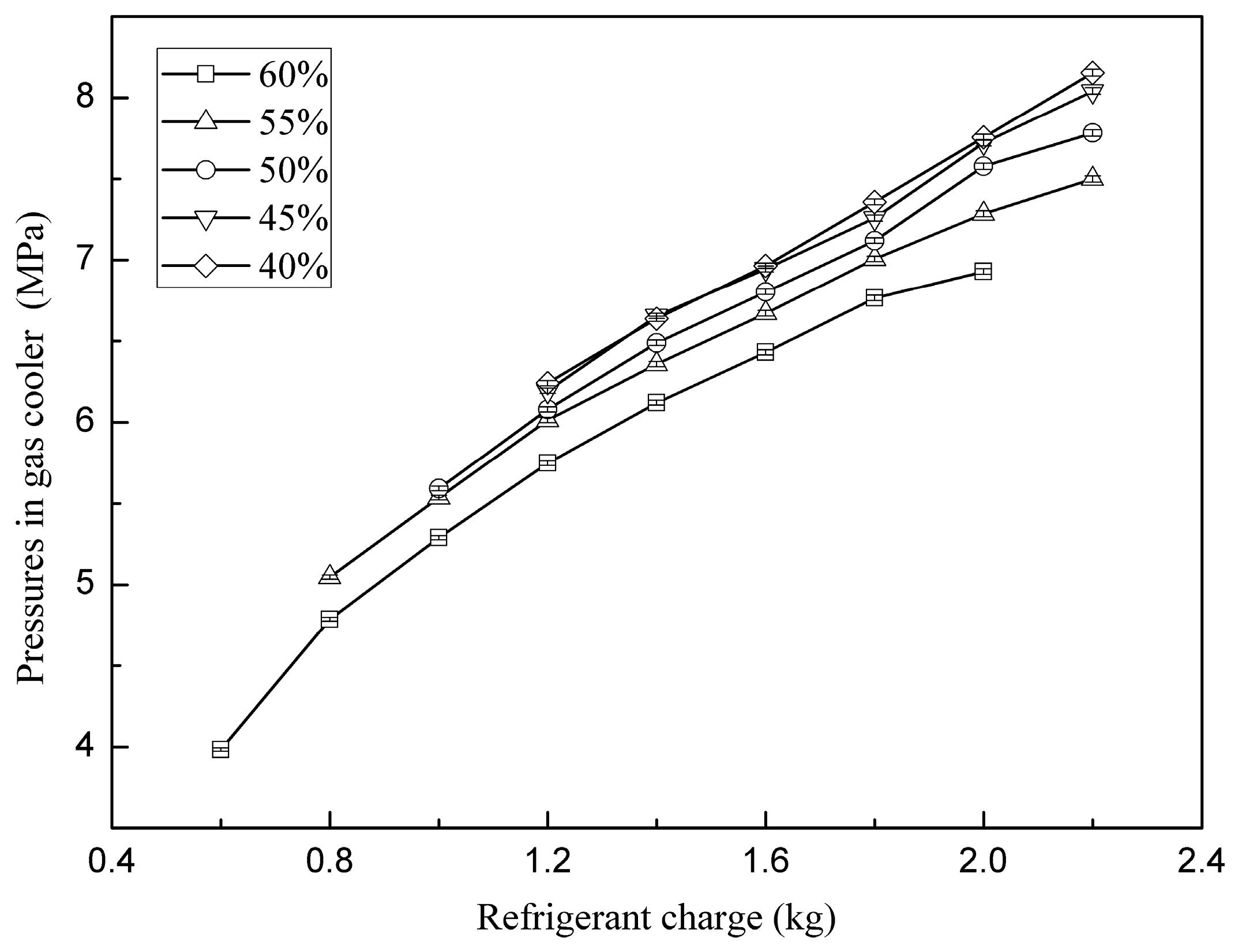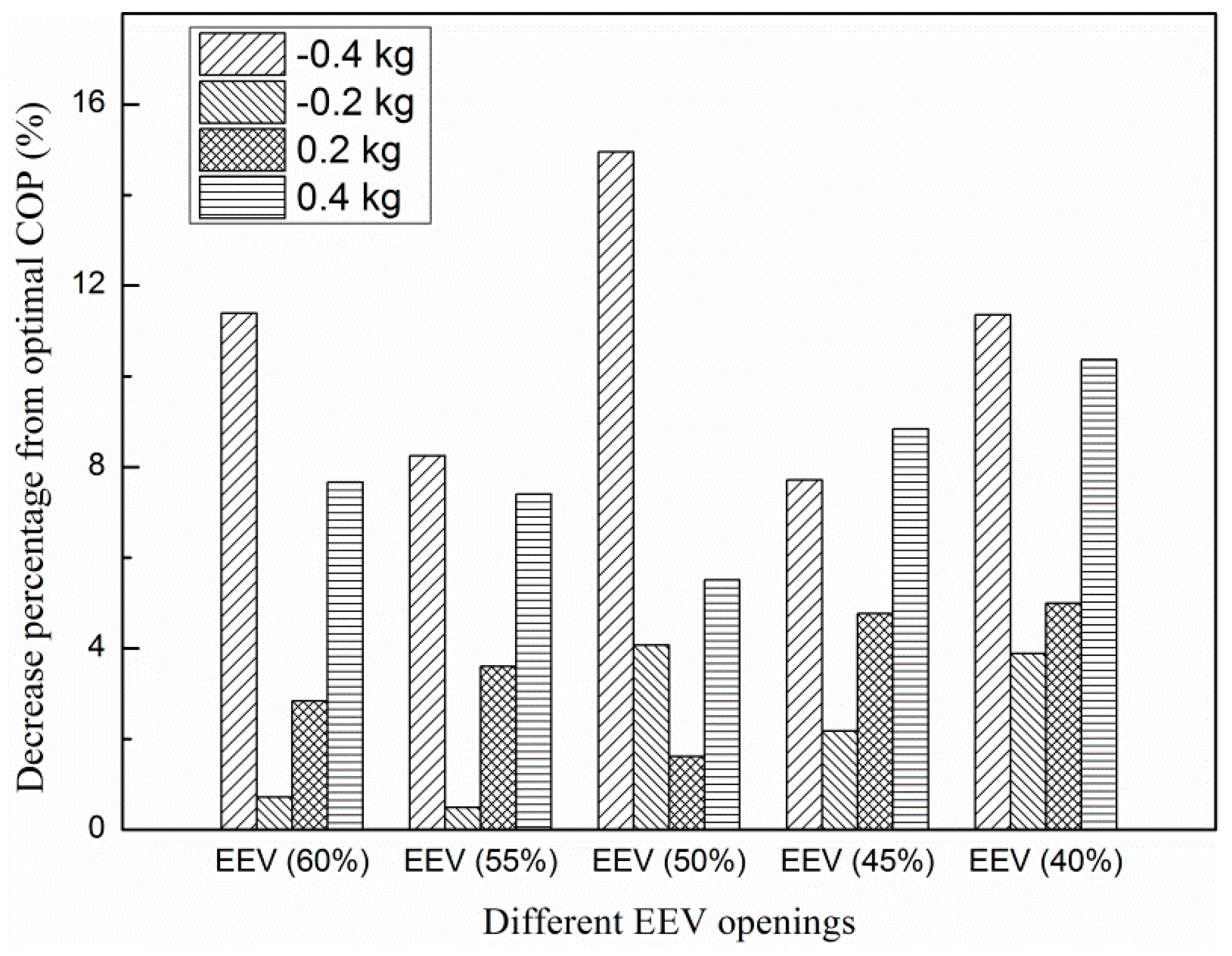1. Introduction
Since chlorofluorocarbon (CFC) and hydro-chlorofluorocarbons (HCFC) were restricted because of the environmental issues, researchers are working on feasible and effective alternative refrigerants. Substantially, carbon dioxide (CO
2, R744) is one of the representatives [
1,
2]. Owing to some properties such as zero ozone depletion potential (ODP), negligible global warming potential (GWP), excellent heat transfer properties, high volumetric capacity and cheap price, carbon dioxide has been widely acknowledged as the most competitive alternative refrigerant. In 1993, a CO
2 transcritical refrigeration system in automotive air conditioning was built and tested [
3]. As time goes on, CO
2 transcritical refrigeration technology is wildly applied in vehicles [
4], water heaters [
5,
6], heat pumps [
6,
7] and low temperature cascade refrigeration systems [
8], and so on.
The coefficient of performance (COP) of a heat pump system is affected by many factors. The amount of refrigerant charge of the system is a primary parameter that influences the energy efficiency. Undercharge or overcharge of refrigerant degrade its performance and deteriorates the system reliability. The electronic expansion valve (EEV) opening is another important parameter that needs to optimize. Therefore, in order to achieve the optimum COP, an appropriate refrigerant charge amount corresponding to a specific EEV opening is important for a heat pump water heater. However, it is difficult to calculate the optimal charge accurately because of the various components and operating parameters. In recent years, research on the lubricating oil, compressor, heat exchanger structure design, the flow and heat transfer performance, and system design have made great progress. But investigations about the influence of the refrigerant charge amount and EEV opening on the performance of transcritical CO2 heat pump systems are limited.
Though the phenomenon that system performance is affected by refrigerant charge has been well known, the method of calculating the optimal refrigerant charge is not well developed. Some mathematical models and evaluating methods have been reported. Zhang et al. [
9] conducted simulation works on the effects of refrigerant charge and structural parameters on the performance of a direct-expansion solar-assisted heat pump system. Vjacheslav et al. [
10] proposed a rationally based model to evaluate the optimal mass charge into refrigerating machines. The calculated results indicate that the system performance is strongly related to the refrigerant mass charge.
There have been a few laboratory studies that have documented the impact of refrigerant charge on the performance of heat pump systems and other refrigeration equipments. Ratts and Brown [
11] tested the effect of refrigerant charge level on the performance of an automotive refrigeration system. They found that a low refrigerant charge level in the system lead to a higher compressor frequency, a lower cooling capacity, a higher refrigeration temperature, and a higher system efficiency. Choi and Kim [
12] experimentally investigated the effect of refrigerant charge on the performance of a water-to-water heat pump using R22 and two kinds of expansion devices. The test results indicate that the EEV system show a smaller variation of the COP according to refrigerant charge than capillary tube system. The results also show that the capillary tube system has lower COP than that of the EEV system at the same operating conditions. A similar work by Choi and Kim [
13] showed the variation of system performance for a water-to-water heat pump with refrigerant charge amount and different expansion devices using R407C. Another water-to-water heat pump system was investigated by Corberán et al. [
14]. In order to optimize refrigerant charge in a reversible water-to-water heat pump using propane as refrigerant, an experimental research was carried out and a mathematical model was set up to predict the distribution of refrigerant within the components of the system. Corberán et al. [
15] also tested the influence of the source and sink temperatures on the optimal charge of a propane water-to-water heat pump. A mathematical model was employed and showed a good agreement with the experiments. Kim and Braun [
16] experimentally investigated the performance of an air conditioner and heat pump using R22 with an electronic expansion valve or a thermostatic expansion valve at various refrigerant charge levels. It was found that the thermostatic expansion valve system is relatively sensitive to refrigerant charge than that of electronic expansion valve system.
In addition, variations of system performance for transcritical CO
2 heat pump systems with refrigerant charge amount have been investigated. Kim et al. [
17] tested the effect of CO
2/propane mixtures charge levels on the cooling performance in an air-conditioning system under different circulation concentrations. They also conducted a comparative study between a CO
2 transcritical cycle and a CO
2/propane mixtures subcritical cycle. It was found that the performance reduction of CO
2/propane mixtures subcritical cycle is higher than that of CO
2 transcritical cycle as the charge amount deviated from the optimal charge. Cho et al. [
18] experimentally investigated the effects of refrigerant charge levels on the performance of a transcritical CO
2 heat pump and entropy generation in each component at standard cooling condition. In order to evaluate the sensitivity of the cycle performance with refrigerant charge, the same system retrofitted with R22, R410A and R407C were tested and compared with CO
2 system. The results showed that the performance reduction of CO
2 cycle is higher than that of other cycles at undercharged conditions and expansion loss is the most important factor leading to the decline of system performance at undercharged conditions.
Although the performance of CO2 heat pumps have been investigated by varying the refrigerant charge amount, studies on controlling refrigerant charge amount by considering EEV opening in transcritical CO2 heat pump water heater are very limited. In this study, a transcritical CO2 heat pump water heater is investigated experimentally to evaluate the effects of EEV opening and refrigerant charge amount on system performance. The effects of refrigerant charge on the key pressures, mass flow rate, power consumption, discharge temperature, superheat, heating capacity and COP were analyzed at different EEV openings. Experimental data obtained from this article can provide a reference for system design in the field of heat pump and a reference for establishment of future mathematic optimization model of system performance.
2. Experimental Setup and Test Procedure
2.1. Experimental Setup
The experimental setup was designed to measure the performance of the transcritical CO
2 heat pump water heater at various refrigerant charge amounts and variable EEV openings.
Figure 1 shows the schematic of experimental setup. The present transcritical CO
2 system consisted of a rotary compressor, an evaporator, an internal heat exchanger (IHX), a gas cooler, and an electronic expansion valve (EEV). A liquid receiver is included in the rotary compressor. The evaporator and the gas cooler had a counter flow pattern between refrigerant and water. The rated power of the compressor is 2.6 kW. EEV was utilized as an expansion device in the CO
2 heat pump system. An adjustable DC power supply was used to control and drive EEV. Pulse values for EEV range from 0 to 480 and it is proportional to EEV input voltage signal. A full stroke (100% opening) of EEV corresponds to 10 V input voltage and a completely close state (0% opening) corresponds to 0 V input voltage. The EEV opening is defined as the ratio of the EEV opening to the full opening. The temperature-entropy diagram of the transcritical CO
2 system is shown in
Figure 1b. The top point which located at where the saturated liquid and saturated vapor lines meet is called critical point. If temperature and pressure of a refrigerant is higher than that of its critical point, it is supercritical fluid. A Cycle where the refrigerant goes through both subcritical and supercritical states is called transcritical cycle.
Table 1 lists the details about the main components of the system. In order to measure heating capacity simply, water was selected as a heat source and sink for the heat pump system. Two cyclic water systems which contain a thermostatic water tank and a water pump were used to keep the thermal balance in both the gas cooler and the evaporator. A few ball valves and needle valves were used to control the water flow rate supplied to the gas cooler and the evaporator. The water inlet temperature can be achieved by the thermostatic water tank.
The calibrated T-type thermocouples were used for measuring temperature. The welding point of the T-type thermocouples was directly attached to the measured point on copper tubes. Pressure sensors (HSK-BC150D, SAGINOMIYA, Tokyo, Japan) were used for pressure measurement. The pressure sensor is a kind of diffused silicon pressure transmitter which is welded to the experimental copper tube. The sensor can convert pressure difference to displacement by detecting the amount of deflection on a diaphragm position. Then the sensor converts this displacement into a voltage output. The power consumption of the compressor was measured by a power meter (QZ8716C1, Qingzhi Instruments, Qingdao, China) with the accuracy of ±0.1% (voltage 10 V to 500 V, current 0.03 A to 40 A). The water flow rate in the evaporator was measured by a ±0.5% accuracy turbine flow meter (LWGYC-20, Beijing Flowmeter Factory, Beijing, China, measurement range from 0.8 m3·h−1 to 8 m3·h−1) and the water flow rate in the gas cooler was measured by a ±0.5% accuracy turbine flow meter (measurement range from 0.1 m3·h−1 to 0.6 m3·h−1). A mass flow meter (SITRANS F C, Siemens Co., Munich, German) was used to measure the CO2 mass flow rate. A data recorder (MV2000, YOKOGAWA, Tokyo, Japan) was used to obtain the data of temperatures, pressures and flow rates. The entire outer surface of experimental setup was covered with thermal insulation cotton in order to avoid heat loss.
2.2. Test Procedure
Before the test, an important step is to ensure that normal signals can be obtained from pressure sensors, thermocouples and volume flow meters. In addition, make sure that the data recorder was set correctly. The next step is to adjust the water temperature at inlet of gas cooler and evaporator. For this test, tap water was used as heat source and sink. The temperature of tap water was 12 °C when the test was operated in local February. After regulating the water flow rate passing through the gas cooler and the evaporator, the experiment can begin. In order to investigate the efficiency of the heat pump system at actual local conditions, the water entering gas cooler was kept at 12 °C which equals the tap water temperature. In order to provide enough heat for vaporization process of liquid refrigerant and avoid excessive low evaporating temperature happening, the temperature of the water passing through the evaporator is higher than that of the tap water. Therefore, the evaporator inlet water temperature was kept at 16.8 °C. The water flow rate passing through the gas cooler and the evaporator were 0.2 m3·h−1 and 1.6 m3·h−1 respectively. In order to investigate the influence of the refrigerant charge and EEV opening on the performance of system, the water inlet temperature and inlet flow rate were constant during the whole test.
As shown in
Figure 1, the working fluid leaves the internal heat exchanger (2) and enters the compressor. The high-pressure vapor leaves the compressor at state (3) and enters the gas cooler. Then the refrigerant transfers the heat to the water of a cyclic water system. In the gas cooler, tap water and refrigerant flows move in opposite directions. At state (4), the cooled CO
2 refrigerant enters the internal heat exchanger and heats the working fluid leaving the evaporator. At state (5), the refrigerant enters expansion device, and then expands to the evaporator pressure at state (6). Then the refrigerant enters the evaporator and absorbs heat from the water of another cyclic water system. Countercurrent heat exchange is also used between two flows in the evaporator.
For this transcritical CO2 water-water heat pump system, the refrigerant was added into the system in 200 g increments. With the increase of refrigerant charge amount, the evaporating temperature increased fast at first and then slowly. At this point, the charging process was stopped. Specifically, the experience of the charging refrigerant which summed up during the test was that the evaporating temperature should better be kept between 0 °C and 16 °C. In this study, the EEV opening was manually varied from 40% to 60% of full opening in 5% increment to investigate the influence of EEV openings on the power consumption, key pressures, superheat, mass flow rate, heating capacity and COP.
The heating capacity
Q is calculated by using water flow rate and water temperature difference between gas cooler inlet and outlet, as shown in Equation (1):
where
is the volume flow rate of water,
is the density of water,
is the constant-pressure specific heat of water, and
is the temperature rise of the water in the gas cooler.
The COP
HP is calculated according to Equation (2):
where W is the compressor power consumption. COP
HP is the heating COP.
The uncertainties of test results were determined by method of Kline and McClintock [
19]. The uncertainty was calculated according to the Equation (3):
where A is a given function of the independent variables,
is the total uncertainty in the result,
is one of the independent variables which impact the dependent variable A, and
is the uncertainty associated with an independent variable
. The uncertainties of experimental parameters are summarized in
Table 2.
4. Conclusions
In order to characterize the effects of EEV opening and refrigerant charge amount on the performance of the water source transcritical CO2 heat pump water heater, experiments were carried out by varying the refrigerant charge with different EEV openings. In general, as the refrigerant charge increased, the pressures increased in both the gas cooler and the evaporator. The heating capacity and heating COP increased rapidly at first, reached their peak, and then decreased with the increase of charge amount at fixed EEV opening. As EEV opening increased, the pressures increased in the evaporator and decreased in the gas cooler. The refrigerant mass flow rate increased with the increase of EEV opening. In addition, the superheat decreased with the increase of EEV opening. The other conclusions are as follows:
- (1)
Both the EEV opening and the refrigerant charge amount had a significant effect on the performance of the system. When the other operating parameters of the system unchanged, an optimal COP was found that corresponded to a specific refrigerant charge and a specific EEV opening. Based on the experiment, the COP peaked at charge of 1.8 kg when EEV opening was 40% of full opening. COP has different maximum value at specific CO2 mass charge when EEV opening was different.
- (2)
As EEV opening increased, the corresponding optimal COP decreased. In addition, different EEV opening led to different COP at the same charge level.
- (3)
It was found that the heating capacity was also affected by the EEV opening at the same charge amount. As EEV opening varied from 40% of full opening to 60%, the heating capacity decreased, at most, more than 30%.
- (4)
As refrigerant charge amount increased, the mass flow rate and compressor power consumption increased gradually, and the superheat and compressor discharge temperature decreased. The main reason for variation of superheat is the increase of refrigerant mass flow rate passing through evaporator. The reason for variation of compressor discharge temperature is the decrease of superheat and the increase of refrigerant mass flow rate.
- (5)
The reduction of COP caused by improper charge amount was larger at undercharged conditions than that at overcharged conditions just when EEV opening was 50% of full opening. Moreover, this tendency was not apparent or even reversed when EEV opening varied.
Therefore, both refrigerant charge amount and EEV opening are important factors influencing the performance of CO2 heat pump system. It is essential to have the optimum amount of refrigerant charge and more precisely, control of EEV opening to ensure highest performance operation of the CO2 heat pump system. Although the optimal values obtained from this study may vary due to the differences in system configuration and system size, the variable relationship between system parameters and EEV opening as well as refrigerant charge can be generalized to other heat pump systems which have the same system components as this study. Control modules which can real-time control the COP of the heat pump system by adjusting EEV opening and refrigerant charge would be the future development direction.
